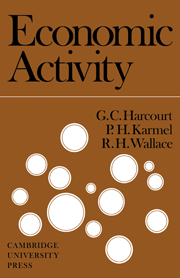Book contents
- Frontmatter
- Preface
- Contents
- 1 INTRODUCTION
- 2 THE NATIONAL ACCOUNTS AND THE INCOME–CREATION PROCESS
- 3 THE PRODUCTION–INCOME–EXPENDITURE CIRCUIT AND NATIONAL ACCOUNTING IDENTITIES
- 4 THE DETERMINATION OF THE EQUILIBRIUM LEVEL OF REAL INCOME
- 5 THE CONCEPT OF FULL EMPLOYMENT
- 6 MONEY IN THE ECONOMIC PROCESS
- 7 THE BANKING SYSTEM AND THE QUANTITY OF MONEY
- 8 THE CONSUMPTION FUNCTION
- 9 THE DETERMINANTS OF INVESTMENT EXPENDITURE
- 10 THE EFFECT OF CHANGES IN EXPENDITURE PLANS: THE MULTIPLIER CONCEPT
- 11 THE GOVERNMENT SECTOR AND THE DETERMINATION OF REAL INCOME
- 12 THE OPEN ECONOMY
- 13 THE INTERACTION BETWEEN PLANNED EXPENDITURES AND FINANCIAL FACTORS
- 14 INFLATION
- 15 ECONOMIC POLICY
- List of suggested reading
- Index
1 - INTRODUCTION
Published online by Cambridge University Press: 18 December 2009
- Frontmatter
- Preface
- Contents
- 1 INTRODUCTION
- 2 THE NATIONAL ACCOUNTS AND THE INCOME–CREATION PROCESS
- 3 THE PRODUCTION–INCOME–EXPENDITURE CIRCUIT AND NATIONAL ACCOUNTING IDENTITIES
- 4 THE DETERMINATION OF THE EQUILIBRIUM LEVEL OF REAL INCOME
- 5 THE CONCEPT OF FULL EMPLOYMENT
- 6 MONEY IN THE ECONOMIC PROCESS
- 7 THE BANKING SYSTEM AND THE QUANTITY OF MONEY
- 8 THE CONSUMPTION FUNCTION
- 9 THE DETERMINANTS OF INVESTMENT EXPENDITURE
- 10 THE EFFECT OF CHANGES IN EXPENDITURE PLANS: THE MULTIPLIER CONCEPT
- 11 THE GOVERNMENT SECTOR AND THE DETERMINATION OF REAL INCOME
- 12 THE OPEN ECONOMY
- 13 THE INTERACTION BETWEEN PLANNED EXPENDITURES AND FINANCIAL FACTORS
- 14 INFLATION
- 15 ECONOMIC POLICY
- List of suggested reading
- Index
Summary
Mass unemployment and year-to-year fluctuations in the level of economic activity were the major economic problems of the interwar years in advanced industrial economies. In the United Kingdom, unemployment did not fall below one million wage-earners for the whole of the interwar period; in Australia, for the same period, it was never less than 5½ per cent of the work force, and for several years in the 1930s it exceeded 25 per cent. It is not surprising, therefore, that the main preoccupation of policy-makers and academic economists alike was to discover the causes of mass unemployment and fluctuations in economic activity, and to devise economic policies which would provide full employment. Pre-eminent among the economists analysing the causes of unemployment was John Maynard Keynes, the great Cambridge economist. His book, The General Theory of Employment, Interest and Money, published in 1936, was the first systematic explanation of the forces which determine the level of economic activity and its associated level of employment; it provided the theoretical backing for subsequent economic policies designed to rid these economies of unemployment with its attendant human misery and waste.
In the post-war period discussions of economic policy have been concerned with other problems and other objectives of economic policy, as well as with the avoidance of mass unemployment. The problems include inflation, disequilibrium in the balance of payments, and continued, if less violent, fluctuations in the level of economic activity.
- Type
- Chapter
- Information
- Economic Activity , pp. 1 - 6Publisher: Cambridge University PressPrint publication year: 1967



